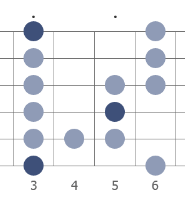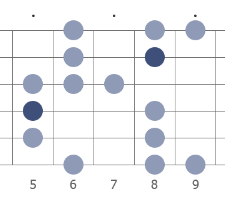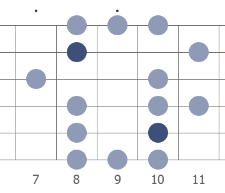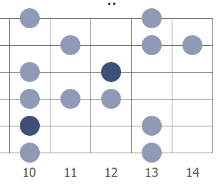What You Need To Know About The C Major Blues Scale

The blues is a foundational genre in music, and understanding its scales is key to unlocking a world of expressive playing. The G Blues Scale is one of the most essential scales in blues music. In this guide, we’ll break down the G Blues Scale, explore its structure, and provide tips for incorporating it when you play it on the guitar.
Understanding the G Blues Scale
The G Blues Scale is a six-note scale that adds a “blue note” to the pentatonic scale, creating a distinct, soulful sound. The notes in the G Blues Scale are: G, Bb, C, Db, D, and F. Here’s the breakdown:
- G (Root)
- Bb (Minor third)
- C (Perfect fourth)
- Db (Diminished fifth, also known as the “blue note”)
- D (Perfect fifth)
- F (Minor seventh)
Playing the G Blues Scale on Guitar
3rd Position

- Start on the 3rd fret of the low E string (G).
- Move to the 6th fret of the low E string (Bb).
- Play the 3rd fret of the A string (C).
- Move to the 5th fret of the A string (Db).
- Play the 3rd fret of the D string (D).
- Move to the 5th fret of the D string (F).
- Repeat this pattern on the G, B, and high E strings.
5th Position

- Low E String: 6th fret (Bb): Use your index finger. 8th fret (C): Use your ring finger.
- A String: 5th fret (D): Use your index finger. 6th fret (Db): Use your middle finger. 7th fret (F): Use your ring finger.
- D String: 5th fret (G): Use your index finger. 7th fret (Bb): Use your ring finger.
- G String: 5th fret (C): Use your index finger. 7th fret (D): Use your ring finger.
- B String: 6th fret (F): Use your index finger. 8th fret (G): Use your ring finger.
- High E String: 6th fret (Bb): Use your index finger. 8th fret (C): Use your ring finger.
8th Position

- Low E String: 8th fret (C) – Use your index finger. 11th fret (D) – Use your pinky finger.
- A String: 8th fret (F) – Use your index finger. 9th fret (Gb) – Use your middle finger. 10th fret (G) – Use your ring finger.
- D String: 8th fret (Bb) – Use your index finger. 10th fret (C) – Use your ring finger.
- G String: 8th fret (Eb) – Use your index finger. 10th fret (F) – Use your ring finger.
- B String: 8th fret (G) – Use your index finger. 11th fret (Bb) – Use your pinky finger.
- High E String: 8th fret (C) – Use your index finger. 11th fret (D) – Use your pinky finger.
10th Position

- Low E String: 10th fret (D) – Use your index finger. 13th fret (F) – Use your pinky finger.
- A String: 10th fret (G) – Use your index finger. 11th fret (Ab) – Use your middle finger. 12th fret (Bb) – Use your ring finger.
- D String: 10th fret (C) – Use your index finger. 12th fret (D) – Use your ring finger.
- G String: 10th fret (F) – Use your index finger. 12th fret (G) – Use your ring finger.
- B String: 11th fret (Bb) – Use your index finger. 13th fret (C) – Use your ring finger.
- High E String: 11th fret (F) – Use your index finger. 13th fret (G) – Use your ring finger.
Tips for Practicing the G Blues Scale
- Start Slow: Begin by playing the scale slowly, ensuring each note rings clearly. Focus on finger placement and accuracy.
- Use a Metronome: Gradually increase your speed using a metronome. This helps in developing a consistent rhythm and timing.
- Experiment with Patterns: Try different picking patterns and rhythms. Alternate picking (down-up strokes) is a good technique to practice.
- Improvise: Use backing tracks in the key of G to practice improvisation. The G Blues Scale is perfect for soloing over blues progressions.
- Bend and Slide: Incorporate techniques like bending and sliding between notes to add expression to your playing.
Applying the G Blues Scale in Music
The G Blues Scale is incredibly versatile and can be used in various musical contexts:
- Blues: Perfect for 12-bar blues progressions. Use it to create solos and riffs.
- Rock: Many rock guitarists incorporate the blues scale into their solos. Experiment with adding distortion for a more aggressive sound.
- Jazz: The blues scale can add a raw, emotional element to jazz improvisation.
Final Thoughts
Mastering the G Blues Scale on the guitar opens up a world of musical possibilities. It’s a scale that embodies the soul and emotion of the blues, and with practice, you’ll be able to infuse your playing with its distinctive character. Remember, the key to mastery is consistent practice and experimentation. So grab your guitar, start slow, and let the blues flow through your fingers. Happy playing!
If you’re interested in learning an instrument, at Real Brave, we offer an incredible experience like no other place in music lessons for kids and adults by guiding them from the beginning stages of getting to know an instrument all the way through performing for family and friends on stage. Our instructors come from all over the world, bringing extensive experience on a wide range of instruments. Click below and book a free lesson with us!
Author: Daniel Powers Jr, the founder of Real Brave™, serves as the chief inspiration to thousands of students in the Real Brave music instruction program. He’s also the visionary behind PracticePad™, an online platform for live one-on-one online music lessons, lesson tracking, and scheduling. Beyond his entrepreneurial pursuits, Daniel leads a non-profit organization that provides formerly homeless children with access to music education, making a profound impact on their lives. His unwavering dedication to music, innovation, and education continues to inspire individuals to reach their fullest potential while creating positive change in communities. Follow Real Brave on all the socials:
youtube.com/@realbraveinc
twitter.com/realbraveinc
https://www.tiktok.com/@realbraveinc
instagram.com/realbraveaudio
facebook.com/realbraveinc






